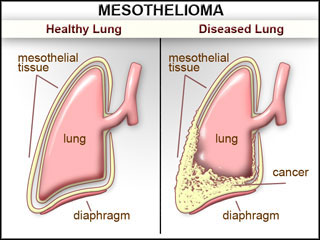

What is Mesothelioma
Mesothelioma is a rare cancer of the serous membranes, especially the pleura and peritoneum, this last site is five to ten times less often affected than the first. The survival rate associated with mesothelioma is very low, with an average survival of 1 year for less than 30% and 5 years for 8%.

Chest radiography, computed tomography and pleural puncture can be used for diagnosis, but the final confirmation requires a biopsy and this confirmation is essentially based on histopathology, with immunohistochemical tests, whose development has greatly improved the accuracy of diagnostics for the past ten years (Carella et al., 2001); New tests more specific become regularly available.

70% to 90% of mesothelioma cases are attributed to occupational exposures, directly or indirectly, to asbestos; the amphiboles (crocidolite, amosite and tremolite) are more strongly associated with mesothelioma than chrysotile. The period of latency would be over 15 years and the risk of this cancer increases with intensity of exposure.
Para-occupational and domestic exposures to asbestos were also associated with an increased risk of mesothelioma, especially among the wives of the workers in asbestos mines and mills, producers of asbestos products, workers in the heating and construction industries.Finally, some exhibitions of geological origin to asbestos fibers (especially tremolite and chrysotile) were also associated with increased rates of mesothelioma among residents in parts of Turkey (Anatolia and Diyarbakir-Cermik), Greece, Cyprus, Corsica and New Caledonia using the local land to coat their homes (INSERM, 1997b).
Some studies suggest that simian virus SV40 and the use of thorium dioxide in diagnostic Radiology may act as a cofactor in the development of mesothelioma.
All the doctors, including pathologists, thoracic surgeons, pulmonologists, radiologists and general practitioners must report all cases of mesothelioma that they diagnose even if the diagnosis is only presumptive.
![]()
![]()
Link Master